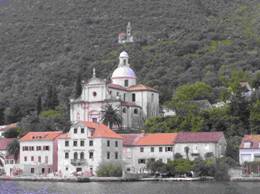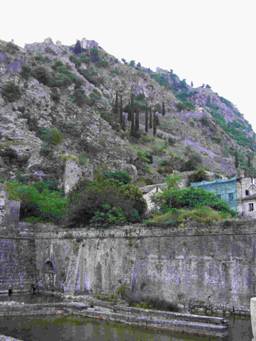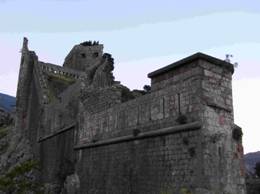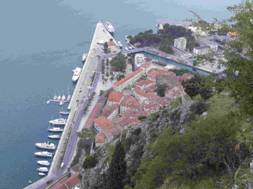Montenegro
Zelenika 42:26.96N
18:34.28E
May 21st finally saw us away from Italy
for real. Motor sailed 12 hours to Budva in Montenegro however contrary to all
the pilot books they aren’t a year round port of entry and the shooed us away to
Zelenika. It was too late in the day so we anchored in Zaljev Traste for the
night and checked in the following day. The staff and personnel could not have
been nicer or more obliging and checking in was a breeze although there is still
a little hangover of the old communist regime with a many page cruising permit
and a place for dozens of stamps. The English translation was cute. Channel
became Channies and Straits became Staits etc.
Tied up stern to at the town dock at KOTOR right at the
southern most end on the BOK KOTORSKA (The Gulf of Kotor). The daily food market
was right across the street and the range of food was great. Cherries are in
season and we tried both the red and black varieties. Irene has been looking for
a cherry pipper for the last few weeks and has tried all the large super
markets. Guess what in a smallish super market just down the road from Kotor,
she found one. Looks like cherry pie and cherry jam coming up.
Badly damaged during the 1979 earthquake, Kotor has now been
restored using UNESCO funding. The old walled town of Kotor has extensive
defensive walls which snake up the hill behind the town. Each detailed level
would have been a defensive position as they fought a rearguard action to the
final keep at the top of the hill.
The next couple days will be spent exploring this part of
Montenegro’s coast before
sailing to Dubrovnik and a rendezvous with our next
guests.
Kotor is an amazing place what to say about it! “When the
pearls of nature were sown, on this soil an overflowing handful was
gathered.” Lord George Gordon Byron.
The narrowest street in the world is in Kotor, it is called
‘Let me pass’. The street is so narrow that two people can barely pass by each
other!
Kotor is located at the south-eastern most point of the
Bay of Kotor and is under the Lovcen Mountain range. While the city itself it
quite small, the city walls are around 5kms long. The two walls both terminate
at the Fortress
St. Ivan which is around 250m high up the mountain
and to climb, it is reputed to have 1426 steps. I ran out of puff and lost count
but I did make it to the top! The walls are impressive being around 20m high and
in places from 2 to 15 metres thick.
Kotor was founded in the 4th & 5th centuries AD by the
Byzantium people
and its original name was Catarum. It was from the 9th century that things
really started to move and the current town dates from then. The city itself has
a definite Venetian influence in the housing and the town presents as a mini
Venice with the
canals being replaced by marble paved streets. It is right up to date shopping
wise with most of the classy names being represented and while there is a fairly
high tourist population, it is a working town occupied by people who live and
work there. I get the feeling it has always been a fairly wealthy town and the
guide book suggests that in 1326 Kotor got its first pharmacy and the hospital
opened in 1350. The pharmacists and doctors were mostly Italian.
St Tryphon’s Cathedral was erected in 1166, rebuilt in the
late 1500’s after the earthquake, again in 1667 after another earthquake and the
latest in 1979 after that huge quake!
There is a small church on Piazza Greca which has a unique
history. It was a Romanesque structure erected at the end of the 12th century
and by the end of the 17th century it was owned by the Catholics and due to an
influx of people around that time it was given over to the Orthodox Church. By
the end of the 19th century there were two altars one each for the Catholics and
the Orthodox and since that time has been a shared facility.
We loved Kotor and if time permits go back again on our way
south in a couple of months.
Brother Stephen, sister-in-law Rhonda together with Bob
Culbert & Lorraine Swan arrive in Dubrovnik
next week so on May 24th we departed for Croatia
(Hrvatska)


Seaside houses,
a cathedral & a church up high The original harbour, the city
walls & St Ivan’s at the top


Battlements run
right up the mountain to St Ivan’s Kotor from St Ivan’s.
It has always been a major maritime trading
city.


Credit for these
two photos goes to Arhiv turističke organizacije Crne Gore as I copied them from
great publication on Montenegro. The picture to the left
is the bell tower on the Chapel Our Lady of the Rosary which Andirja Zmajević
erected as his own mausoleum in 1678. The picture on the right is Our Lady of
the Rock which is an artificial island created by piling up stones around an
existing rock where, according to legend there was found an icon of the Holy
Mother of God. Sailors erected the Testament Church in
1630.

The shared
church, Catholic & Orthodox in Piazza Greca erected towards the end of the
12 century.







